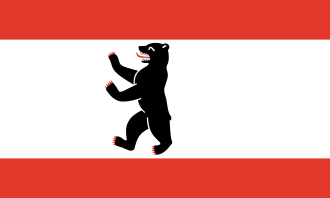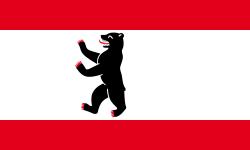 | |
| Landesflagge (state flag) | |
| Use | Civil flag and ensign |
|---|---|
| Proportion | 3:5 |
| Adopted | 26 May 1954 |
| Design | A tricolor of red-white-red, defaced with an emblem. |
The state flag of Berlin, Germany has three stripes of red-white-red, the two outer stripes each occupying a fifth of its height, the middle the remaining three-fifths. It is emblazoned with a bear on the civil flag, while it bears the coat of arms of Berlin on the state flag.
Contents
The civil flag of West Berlin was adopted on 26 May 1954. Designed by Ottfried Neubecker, it came in second in the 1952 contest, the winner having been rejected by the Senate. The bear is placed slightly off-center toward the left.
A bear could be found on seals, coins, and signet rings from as early as the late 12th century (but not as a heraldic charge before 1709), presumably due to a canting association with the city's name. [1]
The state flag replaces the bear with the full coat of arms, with the bear inside the escutcheon. Being the state flag for West Berlin, it became the flag of the entire city after the reunification of Germany in 1990. [2] Prior to that, it had also been the naval ensign, as no other existing flag could be used. The proportions of the flag are 3:5. [3] However, it was only used until 2007 when the Abgeordnetenhaus passed a bill to abolish the state flag. Since then, Berlin has had only one official flag.


















